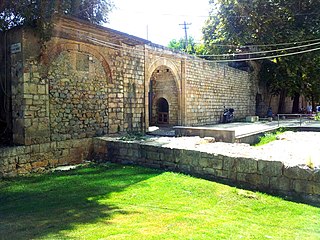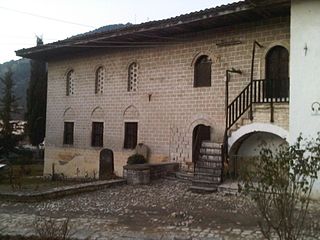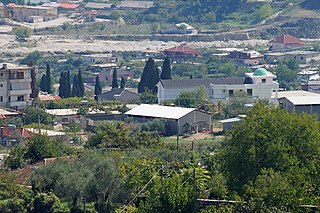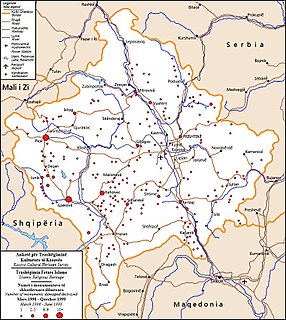
Fortress of Justinian or simply known as Tirana Castle is a castle in Tirana, Albania. Its history dates back before 1300 and is a remnant from the Byzantine-era. The fortress is the place where the main east-west and north-south roads crossed, and formed the heart of Tirana. The current fortification has three known towers and it is undergoing a process of restoration, for touristic purposes. Inside the fortified walls of the former fortress, there are many buildings that can be visited, including restaurants, hotels, and cultural institutions.

Holy Transfiguration Church is an orthodox church in Gjirokastër, Albania. The church was built in 1784. It is a Cultural Monument of Albania since 1963.

The King Mosque, also known as the Sultan's Mosque or Sultan Bayezid Mosque, is a mosque and a Cultural Monument of Albania, located in Berat. It was built in the 15th century by the Ottoman sultan Bayezid II for the local Albanian population. The mosque became a Cultural Monument in 1948.

The Bachelors' Mosque, formerly the Sylejman Pasha Mosque, is a Cultural Monument of Albania, located in Berat. It became a Cultural Monument in 1961.

The White Mosque is a ruined mosque in Berat Castle, Berat, Albania. From the small, roughly square mosque there are still about a meter high foundation walls and the base of the minaret, a little over two meters high. It was built with white limestone.

The Fatih Mosque is a Cultural Monument of Albania, located in Durrës. It was built in 1502 and named after the Ottoman Turkish Sultan Mehmed the Conqueror (Sulltan Mehmet Fatihu). Closed by the Communist authorities, it became a cultural monument in 1973. Its minaret was torn down but rebuilt in a more simple style after the Communist dictatorship had ended.

The Naziresha Mosque is a Cultural Monument of Albania, located in Elbasan. It was built in 1599 by a Naziresha (Nazire), the daughter of a Nazır (minister). After being partly damaged in 1920 due to an earthquake, it became a Cultural Monument in 1948.

The Kapllan Pasha Tomb is a Muslim Türbe of Albania, located in the center of Tirana. It is a Cultural Monument of the first category and was so declared by the government of Albania in 1948. It was built in the early 19th century, with carved stones and has an octagonal shape. The columns are made of stone, and placed also on stone bases and capitals with plant decor on the surface. The former ruler of Tirana was interned here in the 19th century, but was later repatriated back to Istanbul, Turkey.

The Bride's Tomb is a Cultural Monument of Albania, located in Mullet, Tirana County.
The Sheh Dyrri Tekke is a teqe in Tirana, Albania. It is a Cultural Monument of Albania.

The Zall Tekke is a Bektashi teqe in Gjirokastër, Albania. It is a Cultural Monument of Albania.
Kamenicë Church is a ruined church in Palavli, Delvinë, Albania. It is a Cultural Monument of Albania.
Panagia Monastery Church is a monastery church in Dhërmi, Vlorë County, Albania. It is a Cultural Monument of Albania.
Hypapante Church is a church in Dhërmi, Vlorë County, Albania. It is a Cultural Monument of Albania.
St. Stephen's Church is a ruined church in Dhërmi, Vlorë County, Albania. It is a Cultural Monument of Albania.
St. Andrew's Church is a ruined church in Himarë, Vlorë County, Albania. It is a Cultural Monument of Albania.
Allajbegi's Mosque is a Cultural Monument of Albania, located in Burim, Dibër County. The mosque was built before 1585. It became a Cultural Monument in 1970.

The Tekke of Dollmë is a Cultural Monument of Albania, located in Lagjja Kala, Krujë. Beofore its destruction by the Communist dictatorship, the tekke of Krujë had 360 holy graves and was known as "the small Khorasan".

The architectural heritage of the Kosovo Albanians during Yugoslav rule was shown institutionalised disregard for decades prior to outright conflict at the end of the 20th century. Numerous Albanian cultural sites in Kosovo were destroyed during the period of Yugoslav rule and especially the Kosovo conflict (1998-1999) which constituted a war crime violating the Hague and Geneva Conventions. In all, 225 out of 600 mosques in Kosovo were damaged, vandalised, or destroyed alongside other Islamic architecture during the conflict. Additionally 500 Albanian owned kulla dwellings and three out of four well-preserved Ottoman period urban centres located in Kosovo cities were badly damaged resulting in great loss of traditional architecture. Kosovo's public libraries, of which 65 out of 183 were completely destroyed, amounted to a loss of 900,588 volumes, while Islamic libraries sustained damage or destruction resulting in the loss of rare books, manuscripts and other collections of literature. Archives belonging to the Islamic Community of Kosovo, records spanning 500 years, were also destroyed. During the war, Islamic architectural heritage posed for Yugoslav Serb paramilitary and military forces as Albanian patrimony with destruction of non-Serbian architectural heritage being a methodical and planned component of ethnic cleansing in Kosovo.












